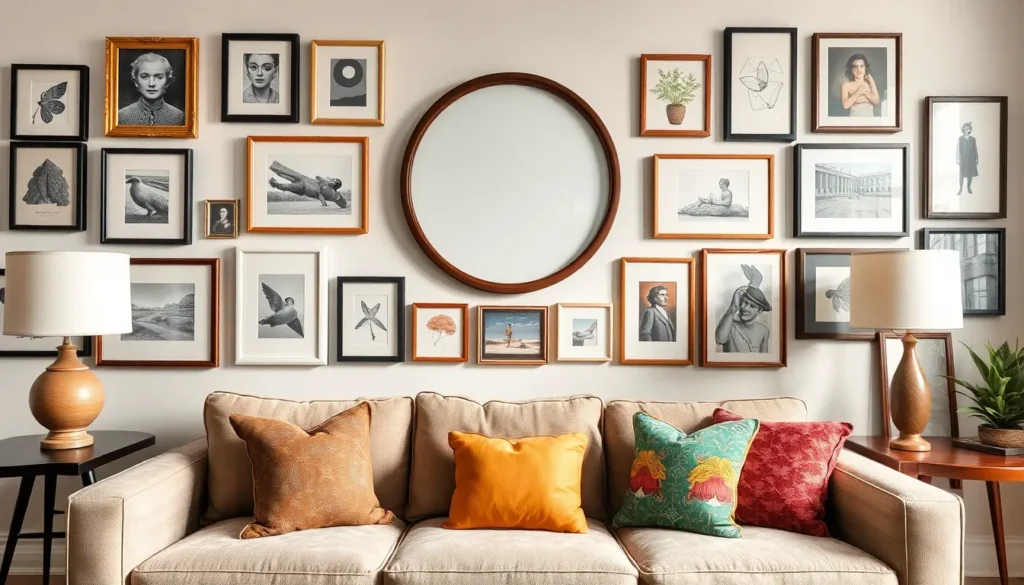Transforming your living room into a stunning visual masterpiece doesn’t require a complete renovation – sometimes all it takes is the perfect selection of frames. We’ve discovered that the right frame choices can instantly elevate your space from ordinary to extraordinary while reflecting your unique personality and style.
Whether you’re working with a cozy apartment or a spacious family room the art of frame placement and selection can make or break your interior design vision. From gallery walls that command attention to single statement pieces that anchor entire rooms we’ll show you how strategic framing creates depth dimension and visual interest.
The best part? You don’t need an interior designer’s budget to achieve professional-looking results. With our carefully curated frame ideas and proven arrangement techniques you’ll learn exactly how to turn blank walls into captivating focal points that guests won’t stop talking about.
Choose the Right Frame Size for Your Living Room Space
Selecting the perfect frame size transforms your living room’s visual balance and creates harmonious proportions throughout the space. We’ll explore how to match frame dimensions with your room’s unique characteristics.
Consider Wall Proportions and Room Scale
Large walls demand substantial frames that command attention without appearing lost in the space. We recommend frames measuring 24×36 inches or larger for expansive wall areas above sofas or entertainment centers. Oversized frames create dramatic focal points that anchor furniture groupings effectively.
Medium sized rooms benefit from versatile 16×20 or 18×24 inch frames that provide visual weight without overwhelming the space. These dimensions work particularly well in apartments or cozy living areas where balance matters most. Multiple frames in these sizes create cohesive gallery arrangements.
Small spaces require careful frame selection to avoid cluttering the visual field. We suggest 8×10 or 11×14 inch frames for compact living rooms or accent walls. Smaller frames allow you to display multiple pieces while maintaining breathing room between elements.
Ceiling height influences frame proportions significantly in ways many homeowners overlook. Rooms with 9 foot ceilings accommodate taller frames that draw the eye upward and create vertical emphasis. Standard 8 foot ceilings work best with horizontal or square frame orientations.
Match Frame Dimensions to Furniture Height
Sofa placement determines optimal frame sizing for the most common living room arrangement. We position frames so their center point sits 57 to 60 inches from the floor, typically 6 to 12 inches above the sofa back. This creates visual connection between seating and wall art.
Console tables and media units require proportional frame selection to maintain balanced compositions. Frames should measure approximately two thirds the width of the furniture piece below them. A 60 inch console pairs beautifully with a 36 to 40 inch wide frame or grouping.
Sectional sofas present unique framing opportunities that deserve special consideration. We recommend creating frame groupings that span 60 to 75 percent of the sectional’s length. This prevents artwork from appearing disconnected from the substantial furniture piece.
Side tables and accent furniture benefit from smaller frame companions that enhance rather than compete with the main wall display. We use 5×7 or 8×10 inch frames on end tables to create layered visual interest throughout the room.
Floating shelves integrate beautifully with mixed frame sizes to create ever-changing wall compositions. We combine 4×6 inch frames with decorative objects and larger statement pieces to build depth and personality in our living room displays.
Select Frame Colors That Complement Your Decor
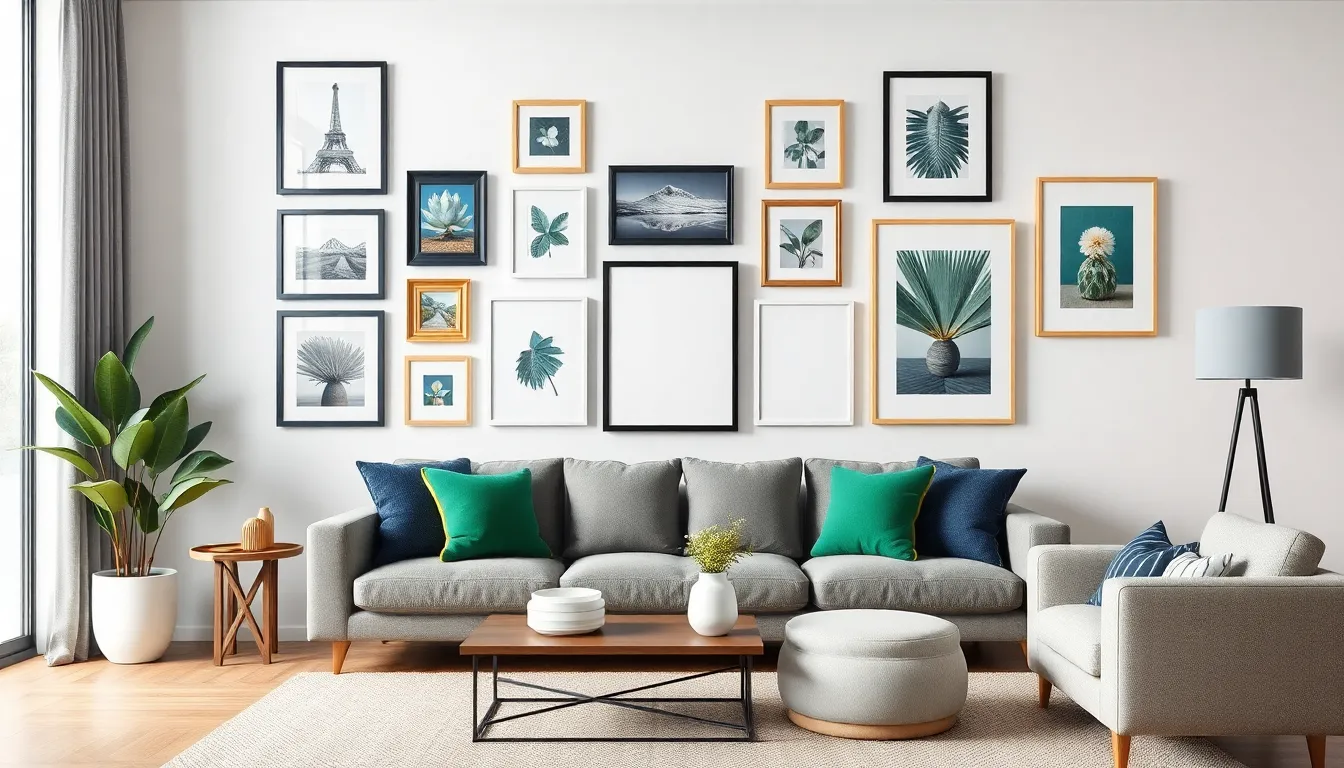
Frame color choices dramatically impact your living room’s visual harmony. We’ll explore strategic approaches to color coordination that elevate your space’s aesthetic appeal.
Coordinate with Existing Color Schemes
Smart frame selection starts with analyzing your current color palette. We recommend pulling colors directly from your sofas, throw pillows, or area rugs to create seamless visual connections throughout the space.
Matching frame colors to existing elements creates a cohesive look that feels intentional rather than random. For instance, if your living room features navy blue accents in cushions or artwork, selecting frames in similar navy tones reinforces that color story.
Complementary colors work beautifully when you want subtle coordination without exact matches. We suggest choosing frame colors that sit adjacent to your dominant room colors on the color wheel, creating pleasing visual relationships that feel balanced and sophisticated.
Use Neutral Tones for Versatile Appeal
Neutral frame colors offer unmatched flexibility for evolving decor styles. White, black, and gray frames serve as versatile backdrops that won’t compete with your artwork or photographs, allowing the content to take center stage.
White frames create clean, gallery-like presentations that work exceptionally well in modern and contemporary living rooms. These frames brighten spaces and make artwork appear more prominent against most wall colors.
Black frames add sophisticated definition and work particularly well with bold artwork or colorful photographs. We find they create striking contrast against light walls while maintaining timeless appeal across different design trends.
Gray frames bridge the gap between stark white and dramatic black options. These tones complement both warm and cool color palettes, making them ideal choices for rooms with mixed color schemes or frequently changing seasonal decor.
Add Bold Colors for Statement Pieces
Bold frame colors transform ordinary artwork into commanding focal points that demand attention. We recommend using vibrant frame colors strategically to highlight your most important pieces or create dramatic contrast in neutral spaces.
Statement frames in colors like deep emerald, rich burgundy, or golden brass can elevate simple prints into conversation pieces. These eye-catching choices work best when limited to one or two pieces per room to maintain visual balance.
Contrasting frame colors create ever-changing tension that energizes your living room walls. For example, bright coral frames against soft gray walls or electric blue frames in an otherwise neutral space add unexpected personality without overwhelming the room’s overall aesthetic.
Mix Different Frame Materials for Visual Interest

Creating visual depth in your living room becomes effortless when you blend different frame materials. We’ll explore how combining various textures and finishes can transform your wall displays into captivating focal points.
Combine Wood and Metal Finishes
Wooden frames paired with metal accents create compelling contrast that adds sophisticated depth to your living room walls. Reclaimed wood frames offer rustic charm when combined with sleek metal frames finished in gold, silver, or copper for an elegant balance. We recommend alternating between warm wood tones and cool metal finishes throughout your gallery wall arrangement.
Metal frames in brass or bronze complement darker wood species like walnut or mahogany beautifully. Silver and chrome finishes work exceptionally well with lighter woods such as oak or pine. You’ll achieve maximum visual interest by varying the proportions of each material rather than using equal amounts.
Incorporate Natural Materials Like Bamboo
Bamboo frames bring an eco-friendly touch that enhances your living room’s natural ambiance. These sustainable options can be seamlessly integrated with other materials to create unique wall displays that reflect environmental consciousness. We’ve found that bamboo frames work particularly well in spaces with plants, woven textures, or earth-tone color schemes.
Natural bamboo’s light color and distinctive grain pattern complement both modern and traditional decor styles. Darker stained bamboo frames provide rich contrast against light-colored walls. You can mix bamboo with reclaimed wood or metal frames to achieve a curated, worldly aesthetic that feels both organic and intentional.
Add Texture with Fabric-Wrapped Frames
Fabric-wrapped frames introduce softness and tactile appeal that balances harder materials in your living room display. We suggest selecting fabrics that match or complement your existing color scheme, such as linen that echoes your sofa upholstery or velvet that coordinates with your throw pillows. This technique allows you to incorporate patterns and textures that tie your wall art into the room’s overall design.
Burlap wrapping creates rustic texture that pairs beautifully with farmhouse or industrial decor. Silk or satin fabrics add luxurious appeal to formal living spaces. You’ll find that fabric-wrapped frames work especially well for family photos or artwork that you want to feel more intimate and personal within your overall gallery arrangement.
Create Gallery Wall Arrangements with Multiple Frames

Gallery walls transform blank spaces into captivating focal points that showcase your personal style. We’ll guide you through professional techniques that ensure your living room frame arrangements look intentionally curated rather than randomly placed.
Plan Your Layout Before Hanging
Arrange frames on the floor first to visualize your complete arrangement before committing to wall placement. This technique saves time and prevents unnecessary holes in your walls while allowing you to experiment with different configurations.
Start with your largest piece as the anchor point, positioning it centrally within your planned arrangement. We recommend building outward from this focal frame, adding smaller pieces like satellites around a central hub while balancing materials and colors throughout the composition.
Create paper templates by tracing each frame onto paper, cutting out the shapes, and taping them to your wall. This method lets you finalize spacing and positioning before picking up your hammer, ensuring every frame lands exactly where you envision it.
Vary Frame Sizes for Ever-changing Displays
Mix large frames with smaller ones to create visual rhythm that draws the eye across your gallery wall. We suggest combining substantial 8″x10″ frames with petite 3″x3″ pieces to establish a pleasing scale variation that prevents monotony.
Orient frames both vertically and horizontally to add movement and energy to your arrangement. This alternating orientation creates visual interest while breaking up predictable patterns that can make gallery walls feel static.
Incorporate various decorative items beyond traditional photographs, including illustrations, small clocks, and artwork to add depth and personality. These diverse elements transform your gallery wall from a simple photo display into a curated collection that tells your story.
Maintain Consistent Spacing Between Frames
Position frames at eye level approximately five feet from the floor to create comfortable viewing angles for most people. This standard height ensures your gallery wall feels naturally integrated into your living space rather than floating too high or sitting too low.
Adjust placement for higher ceilings by hanging frames slightly higher than the standard five-foot rule to maintain visual flow with your room’s proportions. Rooms with soaring ceilings benefit from elevated arrangements that complement the vertical space.
Keep consistent spacing between all frames, typically 2-3 inches apart, to create cohesion while allowing each piece to breathe. This uniform spacing prevents your gallery wall from appearing cluttered while maintaining the visual connection between individual frames.
Position Frames at Optimal Heights for Viewing
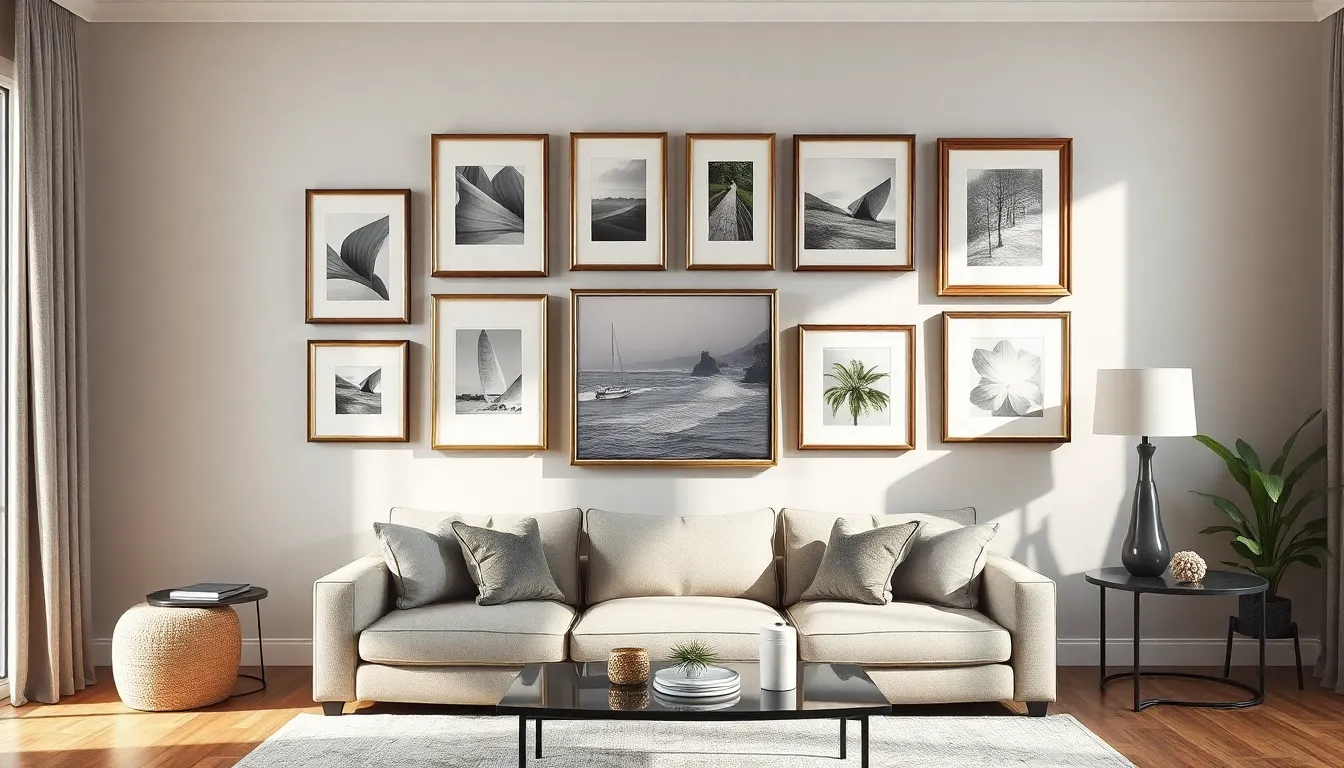
Getting your frame placement just right transforms how artwork interacts with your living space. We’ll show you the professional techniques that ensure your frames create maximum visual impact while maintaining comfortable viewing angles.
Follow the 57-Inch Rule for Eye Level Placement
Apply the 57-inch standard by measuring from the floor to the center of your frame, as this height aligns with average eye level for most people. Museums and galleries use this same measurement because it creates the most comfortable viewing experience for visitors of varying heights.
Adjust within the 57 to 60-inch range depending on your household’s average height and personal preferences. Taller individuals might prefer frames positioned closer to 60 inches, while shorter family members find 57 inches more comfortable for extended viewing.
Mark the center point of your frame before hanging to ensure accuracy, since the hook placement will be several inches above this measurement. We recommend using a pencil to lightly mark the wall at 57 inches, then measuring up from this point to determine your hook placement based on your frame’s hanging hardware.
Adjust Heights Based on Seating Areas
Balance frames with furniture proportions by considering the width and height of pieces like sofas, console tables, and sectional seating when determining optimal placement. Frames hung above furniture should maintain visual harmony with the furniture’s scale rather than strictly following the 57-inch rule.
Position frames 6 to 8 inches above furniture tops to create proper visual separation while maintaining connection between the artwork and seating area. This spacing prevents frames from appearing to float disconnectively above furniture while avoiding a cramped appearance.
Center frame arrangements above furniture pieces by measuring the furniture’s width and positioning your frame or gallery wall to align with these boundaries. We find this creates the most balanced and intentional look, especially when working with larger furniture pieces that anchor the room’s layout.
Account for typical viewing angles from your primary seating positions, as people will most often view your frames while seated rather than standing. Lower placement might work better in rooms where most viewing happens from low seating like floor cushions or sectional sofas.
Consider Lighting When Determining Placement
Avoid glare creating positions by observing how natural and artificial light hits your walls throughout the day before finalizing frame placement. Windows, overhead fixtures, and table lamps can create unwanted reflections that make artwork difficult to view comfortably.
Position frames away from direct light sources that cast harsh shadows or create bright spots on glass surfaces. We recommend testing your chosen location at different times of day to ensure consistent viewing quality regardless of lighting conditions.
Use lighting to enhance your display by positioning frames where they’ll receive gentle, even illumination that highlights the artwork without creating hot spots. Track lighting or picture lights can be adjusted to complement your frame placement rather than competing with it.
Consider seasonal lighting changes when choosing permanent frame locations, as winter and summer sun angles affect how light enters your living room throughout the year. Positions that work well in summer might receive harsh direct light during winter months when the sun sits lower in the sky.
Choose Frame Styles That Match Your Interior Design

We’ve found that selecting frames that complement your interior design style creates a cohesive look throughout your living room. Your frame choices should harmonize with existing furniture and decor elements to achieve professional-level results.
Select Modern Frames for Contemporary Spaces
Modern frames feature thin metal designs that perfectly complement contemporary interiors without overwhelming the space. Sleek profiles in silver and white tones allow your artwork to become the focal point while maintaining clean lines throughout the room.
We recommend choosing flat or rounded metal frames that emphasize simplicity and sophistication. These neutral frame options blend seamlessly with modern furniture pieces like glass coffee tables and leather sectionals.
Contemporary spaces benefit from frames that showcase minimal detailing and geometric shapes. Simple designs create visual harmony with existing modern elements while letting your art collection shine as the primary decorative feature.
Opt for Ornate Frames in Traditional Settings
Ornate frames bring elegance and sophistication to traditional living rooms through intricate carved wooden designs. Gold and bronze finishes add luxurious touches that complement classic furniture pieces and rich fabric textures.
We suggest selecting frames with detailed wood carvings or gold leaf applications that match your existing traditional elements. These ornamental features enhance the formal atmosphere while creating visual connections with antique furniture and classic architectural details.
Rich materials like carved wood and metallic finishes provide the perfect backdrop for traditional artwork and family portraits. Luxurious frame details create focal points that draw attention while maintaining the refined aesthetic of traditional interior design.
Use Minimalist Frames for Scandinavian Decor
Minimalist frames in white, black, or natural wood tones blend effortlessly with Scandinavian interior principles. Ultra-thin profiles emphasize the clean lines and simplicity that define this popular design style.
We recommend choosing frames that virtually disappear into the background while letting your artwork integrate with the overall minimalist aesthetic. Simple frame designs complement the functional beauty and uncluttered spaces typical of Scandinavian homes.
Natural wood frame options particularly enhance the organic elements found in Scandinavian decor like light oak furniture and linen textiles. These understated frames maintain the serene atmosphere while adding warmth through subtle wood grain patterns.
Display Family Photos and Personal Artwork Effectively
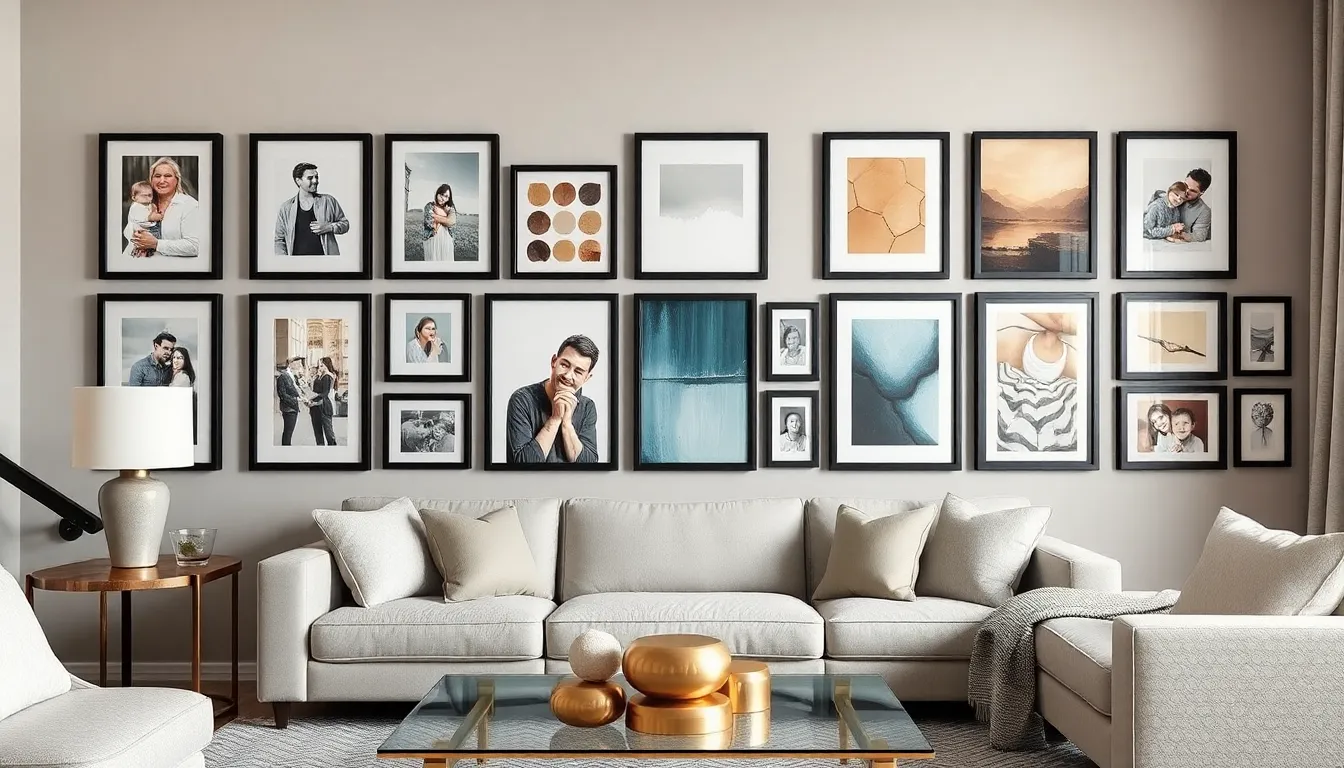
Building on your frame selection and arrangement foundation, we’ll explore how to showcase your most treasured memories alongside beautiful artwork. Personal displays require strategic planning to create meaningful focal points that reflect your unique story.
Create Cohesive Themes Across Multiple Frames
Themed displays organize your frames by exact categories like travel adventures, family gatherings, or milestone celebrations to create visual storytelling throughout your living room. Travel collections work particularly well when arranged chronologically, showcasing your journey from destination to destination in matching frames.
Uniform frame styles maintain consistency across your display by using frames with identical colors, materials, or finishes to create a polished gallery effect. Black frames offer timeless elegance, while white frames provide clean, modern appeal that works with any decor style.
Mixed frame variations add visual interest by combining different sizes and shapes while maintaining consistent design elements like matching wood tones or metal finishes. Rectangle and square combinations create ever-changing arrangements, especially when you alternate between horizontal and vertical orientations.
Color coordination ties your themed displays together by selecting frames that complement your existing furniture and decor palette. Metallic accents from your coffee table or lamp bases can guide your frame finish choices for seamless integration.
Balance Personal Photos with Decorative Art
Combination displays alternate between cherished family photos and decorative artwork to prevent your walls from becoming purely sentimental rather than aesthetically pleasing. Personal photographs should comprise about 60% of your display, with decorative pieces filling the remaining 40% for optimal visual balance.
Gallery wall integration includes both photos and artwork in carefully planned arrangements that create variety and prevent monotony. Large decorative prints work as anchor pieces, while smaller family photos fill surrounding spaces to maintain proportional harmony.
Strategic placement positions your most meaningful photos at eye level, typically around 57 inches from the floor, while decorative art can occupy higher or lower positions. Viewing angles from your main seating areas should showcase your favorite family moments prominently.
Scale considerations ensure that personal photos don’t compete with decorative art by varying their sizes thoughtfully. Smaller family photos grouped together can balance larger decorative pieces, creating visual weight distribution across your wall space.
Rotate Seasonal or Holiday-Themed Displays
Seasonal rotation systems keep your living room displays fresh and current by incorporating holiday themes, seasonal colors, or special occasion photography. Spring displays might feature Easter family gatherings or garden photos, while winter arrangements showcase holiday celebrations and cozy indoor moments.
Quick change answers use slide in frames or photo ledges that allow easy swapping without tools or wall damage. Magnetic frames on metal surfaces or clip systems on wire displays enable instant updates for holidays, birthdays, or seasonal celebrations.
Storage organization keeps your rotating photos protected and easily accessible in labeled containers sorted by season or occasion. Digital printing allows you to create multiple copies of favorite photos in different sizes for various seasonal arrangements.
Transitional elements maintain some consistent photos year round while rotating others to prevent your displays from looking completely different with each change. Neutral anchor pieces provide stability while seasonal additions create timely relevance and visual refresh.
Incorporate Floating Frames for a Modern Look
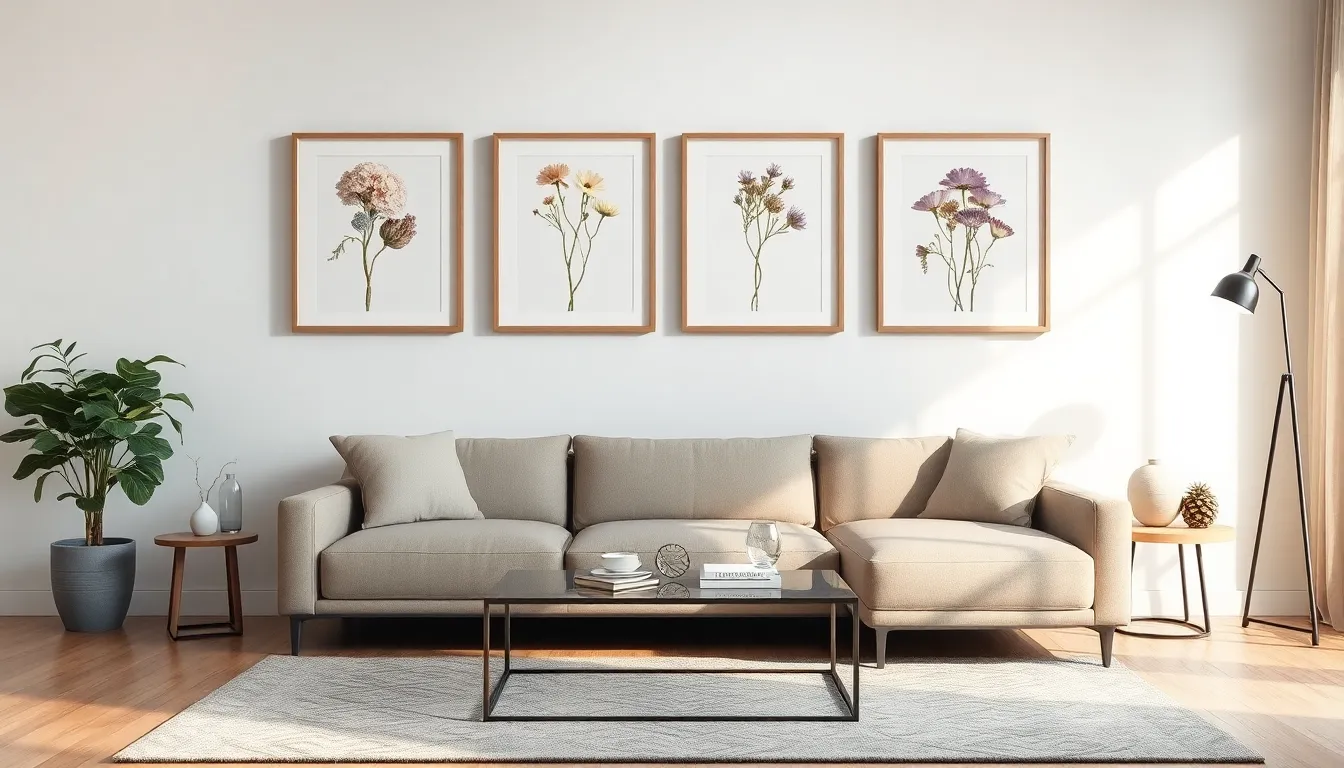
Floating frames create the illusion that your artwork hovers on the wall, delivering that clean contemporary aesthetic we’re all seeking. These sleek frames work perfectly when you want to maintain visual flow while adding sophisticated touches to your living room.
Showcase Pressed Flowers and Botanical Elements
Pressed flowers bring natural beauty into your modern living room when displayed in floating frames. We love how these botanical elements create stunning focal points, especially when you arrange them in clusters of three or five frames along your main wall. Delicate ferns, colorful pansies, and eucalyptus leaves work particularly well for this technique.
Individual specimens look striking in floating frames because the clear space around them emphasizes their natural forms. You can rotate your botanical displays seasonally, swapping spring wildflowers for autumn leaves to keep your living room feeling fresh. This approach works especially well above console tables or sectional sofas where you want organic touches without overwhelming the space.
Display Double-Sided Artwork and Photos
Double-sided floating frames let you showcase two different pieces simultaneously, giving you incredible flexibility for your living room displays. We recommend using this technique for seasonal rotations, placing holiday photos on one side and year-round artwork on the other. This method saves wall space while doubling your display options.
These frames work exceptionally well for creating ever-changing gallery walls where some pieces can be flipped to reveal different imagery. Consider displaying family photos on one side and abstract art on the other, allowing you to adjust the personal versus decorative balance based on occasions. The transparent nature of floating frames makes this dual functionality seamless and sophisticated.
Create Layered Effects with Transparent Materials
Layering transparent materials in floating frames adds incredible depth to your living room walls. We achieve this by placing glass or acrylic elements at different depths within the frame, creating shadow play that changes throughout the day as natural light shifts. This technique works beautifully with pressed botanicals layered between clear sheets.
Multiple transparent layers can hold different elements, such as colored films, textured glass, or even fabric swatches that complement your living room’s color scheme. The key is maintaining visual lightness while adding complexity. These layered floating frames reflect and refract light, making your space appear larger and more luminous, especially when positioned near windows or accent lighting.
Use Statement Frames as Focal Points
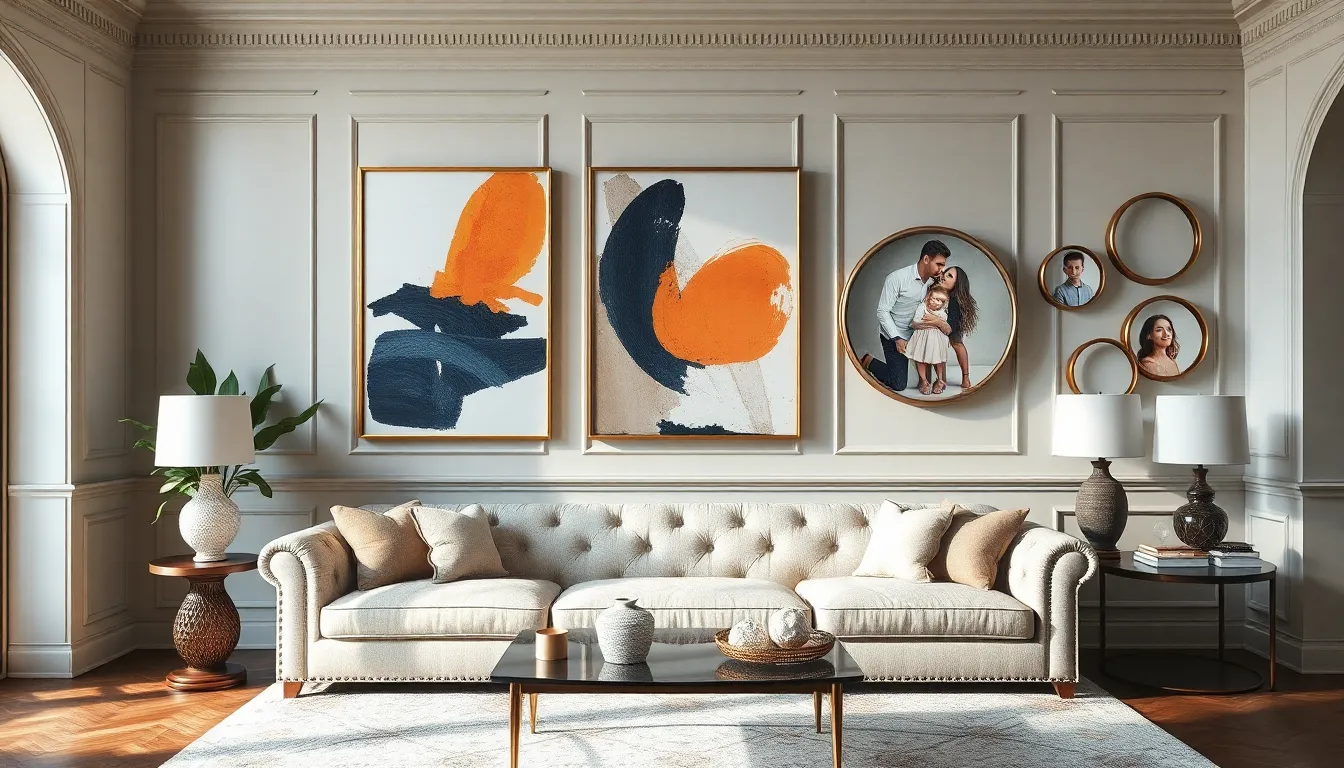
Statement frames transform ordinary wall spaces into commanding visual anchors that draw the eye and define your living room’s character. We’ll explore how strategic frame choices can create dramatic focal points that elevate your entire space.
Choose Oversized Frames for Impact
Oversized frames deliver immediate visual weight that commands attention in any living room setting. We recommend selecting frames measuring 24×36 inches or larger to create bold statements above sofas, fireplace mantels, or console tables. Large-scale frames work particularly well in rooms with high ceilings, where smaller pieces might appear lost or insignificant.
Bold artwork housed in oversized frames becomes the room’s primary conversation starter. We suggest positioning these substantial pieces at eye level, typically 57-60 inches from floor to center, ensuring comfortable viewing from your main seating area. Dramatic landscapes, abstract art, or family portraits gain incredible presence when displayed in generously sized frames.
Proportional balance becomes crucial when working with oversized statement frames. We advise leaving adequate breathing room around large frames, maintaining at least 6-8 inches of clear wall space on all sides to prevent the piece from overwhelming adjacent furniture or architectural elements.
Select Unique Shapes Beyond Traditional Rectangles
Circular frames introduce organic movement that softens angular furniture lines and creates visual interest in geometric living spaces. We love incorporating round mirrors or artwork to break up the rectangular patterns typically found in sofas, coffee tables, and entertainment centers. Hexagonal frames add contemporary flair while maintaining structured appeal.
Oval frames bring classical elegance that works beautifully in traditional or transitional living rooms. We recommend using oval statement pieces to display family portraits or vintage artwork, creating sophisticated focal points that honor both form and content. Arched frames echo architectural details found in doorways and windows.
Mixed geometric shapes create ever-changing gallery arrangements that capture attention through visual variety. We suggest combining circular, rectangular, and hexagonal frames in coordinated finishes to maintain cohesion while adding sculptural dimension to your walls.
Incorporate Architectural Frame Elements
Built-in frame effects using molding and trim create sophisticated focal points that appear custom-designed for your space. We recommend installing decorative molding around existing artwork or mirrors to enhance their visual impact while adding architectural interest. Crown molding, chair rail, or picture frame molding can transform ordinary wall sections into elegant display areas.
Recessed frame niches carved into walls provide three-dimensional display opportunities that create dramatic shadows and depth. We suggest working with contractors to create shallow alcoves that can house artwork, decorative objects, or lighting elements. These architectural frames become permanent focal points that add value to your home.
Faux frame treatments using paint or wallpaper can simulate architectural details without major construction. We recommend using painter’s tape to create clean lines around artwork or mirrors, then painting the “frame” area in contrasting colors or applying textured wallpaper for added visual interest.
Conclusion
We’ve shown you how thoughtful frame choices can completely transform your living room without very costly. From selecting the perfect sizes and colors to creating stunning gallery walls these techniques work together to elevate your space’s visual appeal.
Remember that successful framing isn’t just about hanging pictures—it’s about creating cohesive displays that reflect your personality while complementing your existing decor. Whether you’re showcasing family memories or incorporating modern floating frames the key lies in balancing proportion placement and style.
Your living room walls are waiting to tell your story. Start with one anchor piece and build from there using the strategies we’ve shared. With careful planning and creative execution you’ll transform those blank walls into captivating focal points that guests will admire for years to come.
Frequently Asked Questions
How do I choose the right frame size for my living room walls?
Consider your wall proportions and room scale when selecting frame sizes. Use larger frames (24+ inches) for expansive walls, medium frames (12-24 inches) for versatile arrangements in average-sized rooms, and smaller frames (8-12 inches) for compact spaces. Factor in ceiling height and match frame dimensions to furniture height for proper visual balance.
What frame colors work best with existing living room decor?
Coordinate frame colors with your existing decor by pulling hues from sofas, throw pillows, or area rugs. Neutral tones like white, black, and gray offer versatility and let artwork shine. Use complementary colors for subtle coordination, or choose bold frame colors strategically to create statement pieces while maintaining visual balance.
How can I create an effective gallery wall arrangement?
Start by arranging frames on the floor first, then use paper templates to visualize spacing before hanging. Begin with a large anchor piece and build outward with smaller frames. Vary frame sizes and orientations to create visual rhythm, and incorporate diverse decorative items to add depth and personality to your display.
What’s the proper height for hanging frames in a living room?
Follow the “57-inch rule” by positioning frame centers at 57 inches from the floor for optimal viewing. Adjust based on your household’s average height and furniture proportions. Consider viewing angles from seating areas and account for ceiling height – higher ceilings may require slightly elevated positioning for proper visual flow.
How do I mix different frame materials effectively?
Combine wood and metal finishes for sophisticated contrast, such as reclaimed wood frames with sleek metal accents. Incorporate natural materials like bamboo for an eco-friendly touch. Add fabric-wrapped frames to introduce softness and texture. The key is maintaining balance while creating visual interest through material variety.
What frame styles suit different interior design themes?
Choose modern frames with thin metal designs for contemporary spaces. Select ornate frames with intricate carvings for traditional settings. Opt for minimalist frames with clean lines for Scandinavian decor. Ensure your frame style harmonizes with existing furniture and decor elements to maintain design cohesion throughout your living room.
How should I display family photos alongside decorative art?
Create cohesive themes by organizing displays into categories like travel or family gatherings. Use uniform frame styles for consistency or mix variations for added interest. Maintain visual balance by making personal photographs about 60% of your display, with decorative art comprising the remainder for optimal aesthetic appeal.
What are floating frames and how do I use them?
Floating frames create the illusion of artwork hovering on the wall, offering a clean contemporary aesthetic. They’re perfect for showcasing pressed flowers, botanical elements, or lightweight artwork. Use double-sided floating frames for seasonal rotations, and create layered effects with transparent materials to enhance depth and make spaces appear larger.

